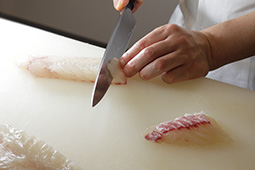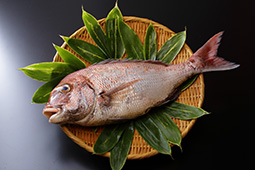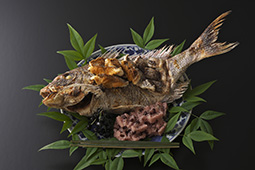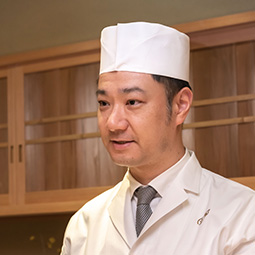May 2023
- English
- 日本語
Sea Bream, Hegi-zukuri Style: Capturing the Spirit of Kyoto Cuisine
-

Sea bream otsukuri (sashimi) cut using the hegi-zukuri method, served around the year at Hyotei -

The front entrance of Hyotei, a renowned traditional Japanese restaurant with a history of over 450 years
-

Sea bream otsukuri (sashimi) presented like a work of art -

Preparing sea bream otsukuri. The chef slices the fillet at an angle rather than perpendicularly, using a sashimi cutting technique known as hegi-zukuri. This technique preserves the texture of the sea bream in just the right condition: firm and pleasantly-chewy. -

Akashi sea bream is the highest grade of sea bream. In May of this year, the Akashi-ura Fisheries Cooperative awarded Takahashi and his father with the title "Sustainability Ambassadors" for their efforts in promoting the taste of Akashi sea bream around the world. -

A whole grilled sea bream. It is grilled over charcoal, but apparently it is extremely difficult to ensure that the fillets, bones, and head are all grilled evenly. -

Takahashi Yoshihiro, the 15th head of Hyotei

The 15th head of one of Kyoto's most famous traditional Japanese restaurants — which has been in business for more than 450 years — reveals the deep connection between Kyoto cuisine and sea bream.
In 2022, the Japanese government designated Kyoto cuisine an Intangible Cultural Property, citing its role as a culinary tradition that conveys the significance of Japanese culture and its high artistic value as a form of cooking, presentation, hospitality, and food developed in the Kyoto area.

One of the most renowned traditional Japanese restaurants where visitors can experience the essence of Kyoto cuisine is Hyotei. In a serene atmosphere that evokes the long history of the restaurant, each dish is presented in a way that allows customers to enjoy not only the refined taste but also the beauty of the ingredients. Takahashi Yoshihiro, the 15th head of the family that runs Hyotei, spoke with us about the sea bream, an essential ingredient in the restaurant's menu.

"We use sea bream in the otsukuri served in our restaurant. In certain seasons, we also serve sea bream in grilled dishes and takiawase.* In spring, when they carry eggs, we use sea bream milt and sea bream roe in our dishes."
For its sea bream otsukuri dishes, the restaurant uses only female Akashi sea bream (see "Akashi Sea Bream: Japan's Most Prized Sea Bream") weighing between 1.8kg and 2.5kg.

"Until the generation before my father's, the restaurant used various types of fish to prepare otsukuri, but since the years of my father, Eiichi, we decided that the fish for otsukuri would always use sea bream. This happened after an encounter with a katsugi-ya, or 'carrier,' who purchases Akashi sea bream from various fishing ports in the Seto Inland Sea in the middle of the night and transports it to Kyoto. Now, the best and freshest Akashi sea bream is available in a stable supply throughout the year."

Hyotei also offers whole grilled sea bream served okashira-tsuki style (with the head and tail attached) for special festive occasions, such as kanreki (60th birthday) celebrations and wedding receptions.
"First, we carve out only the fillet of the sea bream and grill the remaining fish with the head and tail connected by the backbone. Then we grill a portion of the fillet with a sprinkling of dried mullet roe powder** and another portion with red perilla powder to create a grilled fish in red and white (a color combination used in celebratory occasions in Japan). Finally, we place the grilled fillet on the okashira-tsuki sea bream and serve it on a platter with red rice."

Takahashi attributes the development of Kyoto's elaborate, sophisticated cuisine, which makes the most of the original flavor of ingredients while also providing aesthetic delight, to the natural environment surrounding the city. "Located in an inland basin, Kyoto was not blessed with ideal conditions to obtain fresh seafood," says Takahashi. "However, due to its historical background as the capital where the Imperial Family resided for more than 1,000 years, Kyoto became the recipient of abundant food offerings from all over the country. This played a significant role in the development of Kyoto cuisine. Research on cooking methods to efficiently use the dried foods and kobujime*** delivered by ship, and knife techniques to cut the bones of hamo (conger pike)**** and other fish also flourished. Kyoto cuisine is a comprehensive culture born from the combination of various culinary styles, such as the cuisine of the aristocracy, Buddhist vegetarian cuisine, and kaiseki cuisine, which has its roots in the tea ceremony."
Takahashi uses the metaphor of classical music, where even the same piece of music can sound different depending on the conductor's interpretation, to describe his hopes. He wishes his restaurant not only to preserve the traditional flavors that have been passed down through the generations, but also to provide customers with unique opportunities to enjoy culinary transformations born from the restaurant's own interpretation of ingredients, preparation methods, and the changing seasons. "Many customers are surprised to find that the sea bream they eat at our restaurant is completely different from the sea bream dishes they have had before. It is a special fish for the Japanese people, and I hope that visitors will try our Kyoto cuisine version of the sea bream, which is known as the king of otsukuri."

* Fish, vegetables, meat, and other ingredients, each cooked separately, and served together in one dish
** Mullet roe that is salted, then dried, and finally powdered
*** A traditional method of preparing food by curing it between layers of konbu, which infuses it with umami (savory flavor). Dishes prepared using this method are also called kobujime.
**** A species of eel that belongs to the Muraenesocidae family. It is elongated and cylindrical in shape, with most reaching about one meter in length. The fish has many fine and hard bones, so it must be treated using a technique called hone-giri, in which a knife is used to crush the tiny bones in advance.

